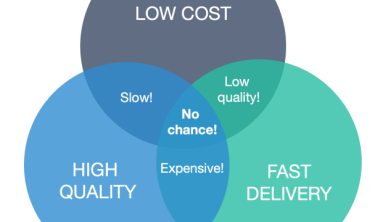As IT outsourcing moves well into its third decade, IT decision makers have made great strides in maturity, managing to avoid some common and costly pitfalls of the practice. As clients enter into their next-generation outsourcing deals today, they’re doing a number of things right, says Randy Wiele, managing director with KPMG’s Shared Services and Outsourcing Advisory. They tend to create better service levels that more accurately reflect real performance and end user experience, recognize the importance of service integration and process alignment, keep strategic elements close to home, and develop more flexible contracts — just for a start.
However, there are a number of common — and costly — pitfalls that persist, as well as some emerging errors IT leaders are making with their latest outsourcing deals. Taking care to avoid these outsourcing missteps will go a long way toward fostering IT services engagements that achieve their intended results.
Switching providers instead of addressing root causes
IT leaders understand the importance of agility in the digital era, and they’ve put in place shorter outsourcing contracts — often with multiple providers — to maintain that flexibility and leverage. However, some outsourcing customers are too focused on changing providers and lose sight of the role their organizations play in the engagement. They “spend too much time trying to switch providers and not addressing the core issues,” says Wiele of KPMG, “which are going to be a problem with any provider.” IT service buyers should take the time to fully understand their role in a successful sourcing relationship rather than reflexively blaming the service provider
Focusing on solutions, rather than problems
“The most common mistake is to take a technology focus, which is easily done given the substantial digital hype that’s out there these days,” says Ollie O’Donoghue, research director with outsourcing research firm and consultancy HfS Research. “Buying the latest shiniest toy rarely delivers results.” IT leaders instead need to invest time in determining what business problems they’re trying to solve, or outcomes they want to achieve, before signing any IT services deals. That means bringing business peers and users into the conversation. “Bringing in a diverse range of stakeholders from across the business will help bring in fresh perspective and will help reimagine challenges, or open the scope of an engagement to areas of the business that had previously been left out,” O’Donoghue says.
Focusing on procuring the lowest price for pre-defined solutions is less common than in the past, says Abhishek Sharma, vice president of pricing assurance with outsourcing consultancy Everest Group. “Manifestations of this could be frequent change requests and demand for ad-hoc specialist resources that come at a premium fee, both of which dilute the business case and impact the confidence in outsourcing,” Sharma says.
Contracting for innovation
Companies are struggling to compete in the dynamic digital era, so it’s only natural that they look to their IT service providers for help. The only problem is that it’s nearly impossible to write an RFP for disruption.
“Clients complain that they don’t get creativity and innovation from their service provider. However, they also want to run this procurement process in a traditional RFP manner with tight rules with no flexibility,” says Jimit Arora, a partner with IT services at Everest Group. “Our experience suggests that in a majority of situations it is not the service providers but the enterprises that are the true limitation for achieving innovation.”
Clients that want something different must build an environment and culture that encourages that, says Steve Hall, president, EMEA, and partner, digital solutions at technology research and advisory firm Information Services Group (ISG). “Create innovation forums. Engage your business stakeholders. Engage the provider team and show respect for their ideas,” Hall says. “Innovation comes from leadership to create the conditions for innovation. You may not be able to execute on all the ideas but doing none of them is a sure way to dampen the creative juices of both provider and client teams.”
Relying on an outsourcing template
IT leaders should never defer to another organization’s approach. “Instead ensure there is thoughtful contemplation of organizational needs and think critically about how to scope and specify outsourcing transactions that add value in your unique situation,” says Marc Tanowitz, managing director for business transformation and outsourcing advisory firm Pace Harmon. “Outsourcing best practices require determining the proper scope, financial framework, and risk profile for your enterprise and its objectives, goals, and culture.”
Playing hardball on terms and conditions
Insisting on overly stringent terms during outsourcing negotiations can impact the provider’s business model and come back to bite the customer. “Certain contract tenets have a direct bearing on price and, in our experience across multiple engagement reviews, the cumulative impact could be as high as 5 to 7 percent of the total contract value” says Sharma. “While contracting, the objective of negotiation should be to ensure alignment with the organization’s requirements and not to put the provider in the tightest situation.”
Underestimating the human impact
Many IT and business leaders fail to plan for the significant change required in an outsourced environment. As a result, they tend to encounter significant barriers to achieving their intended outcomes. Too often, leaders assume their current organization can handle the new service delivery model until it suddenly becomes clear they cannot.
“Don’t assume your staff in place is the right team to manage the services,” says Hall of ISG. “There are important relationship skills required to work with a third party — some people can learn them, some people never will. One difficult team member can break the work of many thoughtful people.”
IT leaders should “actively and honestly communicate, addressing specific stakeholder group concerns and needs,” says Anshul Varma, managing director with KPMG Shared Services & Outsourcing Advisory. Ensuring key employees have a secure transition process, developing retraining programs, and bringing in new talent as needed is essential.
Insufficient focus on transition
The hand-off from the retained IT organization to the service provider is a pivotal point in the outsourcing engagement, and one that requires significant planning and oversight. Companies that overlook transition strategy are likely to suffer delays in or loss of benefits, loss of stakeholder confidence and support, and business disruption, says Varma.
Outsourcing customers and providers should begin any engagement with a clear and agreed-upon understanding of the baseline environment — including processes, systems, service levels, volumes, contracts, and exceptions — and explicitly plan out the knowledge transfer process. They should develop contingency plans and mitigate the impact to key work activities, such as a company’s quarterly financial close, with overlapping staffing in the beginning, advises Varma.
IT leaders should also plan ahead for items with long lead times, such as technology that will have to be built or acquired or team members that need to be recruited. Most important, they should build a strong transition team or program management office capable of rolling with the punches. The key is to “be creative,” says Varma, “and not get bogged down with constraints too easily.”
Inadequately investing in governance
A robust governance model and framework — which includes the service delivery management team, business stakeholders, executives, and the vendor management team — is a must. “Without this, misunderstanding often occurs around who makes decisions and how they are made, where issues should be escalated, and who the relationship counterparts are between the two organizations,” Hall says. That results in infighting, degraded service, unmet demand, and cost overruns, says KPMG’s Varma. IT leaders should also note that the governance model and framework for the early stages of the outsourcing relationship will need to evolve for steady-state management, Sharma says. “Build the key stakeholders into the governance model and keep them involved.”
Managing by service-level-agreement (SLA)
SLAs, which detail the expectations of service type and quality from a vendor and provide remedies when requirements aren’t met, remain a critical component of any IT services contract. While well-thought-out SLAs are necessary, they are not sufficient to ensure provider performance in an outsourcing engagement.
“Selecting and managing the right service levels is a critical process and a living process,” says ISG’s Hall. “It’s not once and done.” IT service buyers must review and look for ways to improve them throughout the life of the contract.
“And while solid service levels are good, in the agile world providers and clients are turning to outcome-based contracting, using aggregated service-level metrics, to achieve better results in outsourcing,” Hall says. “This needs a strong governance relationship to work well.”
Via cio.com






